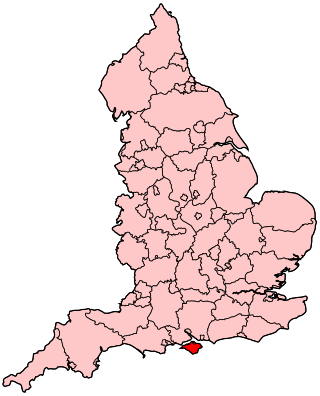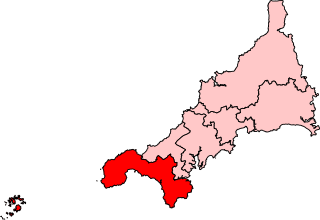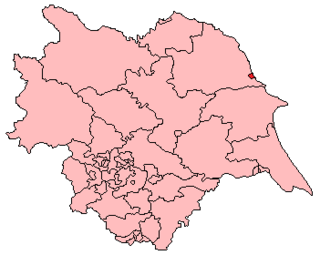
Great Yarmouth is a constituency represented in the House of Commons of the Parliament of the United Kingdom since the 2024 general election by Rupert Lowe of Reform UK.

Isle of Wight was a constituency that was last represented in the House of Commons of the UK Parliament from 2017 until 2024 by Bob Seely, a Conservative.

St Ives is a parliamentary constituency covering the western end of Cornwall and the Isles of Scilly. The constituency has been represented in the House of Commons of the UK Parliament since 2024 by Andrew George, a Liberal Democrat; George previously represented the constituency from 1997 to 2015.
Newtown was a parliamentary borough located in Newtown on the Isle of Wight, which was represented in the House of Commons of England until 1707, then in the House of Commons of Great Britain from 1707 to 1800, and finally in the House of Commons of the United Kingdom from 1801 to 1832. It was represented by two members of parliament (MPs), elected by the bloc vote system.
Yarmouth was a borough constituency of the House of Commons of England then of the House of Commons of Great Britain from 1707 to 1800 and of the House of Commons of the United Kingdom from 1801 to 1832. It was represented by two members of parliament (MPs), elected by the bloc vote system.
Liverpool was a borough constituency in the county of Lancashire of the House of Commons for the Parliament of England to 1706 then of the Parliament of Great Britain from 1707 to 1800 and of the Parliament of the United Kingdom from 1801 to 1885. It was represented by two Members of Parliament (MPs). In 1868, this was increased to three Members of Parliament.

Scarborough was the name of a constituency in Yorkshire, electing Members of Parliament to the House of Commons, at two periods. From 1295 until 1918 it was a parliamentary borough consisting only of the town of Scarborough, electing two MPs until 1885 and one from 1885 until 1918. In 1974 the name was revived for a county constituency, covering a much wider area; this constituency was abolished in 1997.
Malton, also called New Malton, was a constituency of the House of Commons of the Parliament of England in 1295 and 1298, and again from 1640, then of the Parliament of Great Britain from 1707 to 1800 and of the Parliament of the United Kingdom from 1801 to 1885. It was represented by two Members of Parliament until 1868, among them the political philosopher Edmund Burke, and by one member from 1868 to 1885.

Leeds was a parliamentary borough covering the town of Leeds, in the West Riding of Yorkshire, England. It was represented in the House of Commons of the Parliament of the United Kingdom from 1832 to 1885.
Rye was a parliamentary constituency centred on the town of Rye in East Sussex. It returned two Members of Parliament to the Parliament of England before 1707, Parliament of Great Britain until 1801 and the House of Commons of the Parliament of the United Kingdom until its representation was halved under the Reform Act 1832.
Cockermouth was the name of a constituency of the House of Commons of the Parliament of England in 1295, and again from 1641, then of the Parliament of Great Britain from 1707 to 1800 and of the Parliament of the United Kingdom from 1801 to 1918. It was a parliamentary borough represented by two Members of Parliament until 1868, and by one member from 1868 to 1885. The name was then transferred to a county constituency electing one MP from 1885 until 1918.
Kingston upon Hull, often simply referred to as Hull, was a parliamentary constituency in Yorkshire, electing two members of parliament to the Parliaments of England, Great Britain and House of Commons of the Parliament of the United Kingdom, from 1305 until 1885. Its MPs included the anti-slavery campaigner, William Wilberforce, and the poet Andrew Marvell.
Monmouth Boroughs was a parliamentary constituency consisting of several towns in Monmouthshire. It returned one Member of Parliament (MP) to the House of Commons of the Parliaments of England, Great Britain, and finally the United Kingdom; until 1832 the constituency was known simply as Monmouth, though it included other "contributory boroughs".
Lostwithiel was a rotten borough in Cornwall which returned two Members of Parliament to the House of Commons in the English and later British Parliament from 1304 to 1832, when it was abolished by the Great Reform Act.
Midhurst was a parliamentary borough in Sussex, which elected two Members of Parliament (MPs) to the House of Commons from 1311 until 1832, and then one member from 1832 until 1885, when the constituency was abolished. Before the Great Reform Act 1832, it was one of the most notorious of England's rotten boroughs.
Boston was a parliamentary borough in Lincolnshire, which elected two Members of Parliament (MPs) to the House of Commons from 1547 until 1885, and then one member from 1885 until 1918, when the constituency was abolished.
Portsmouth was a borough constituency based upon the borough of Portsmouth in Hampshire. It returned two members of parliament (MPs) to the Parliaments of England, Great Britain and from 1801 the House of Commons of the Parliament of the United Kingdom, elected by the bloc vote system.
Liskeard was a parliamentary borough in Cornwall, which elected two Members of Parliament (MPs) to the House of Commons from 1295 until 1832, and then one member from 1832 until 1885. The constituency was abolished by the Redistribution of Seats Act 1885.
Malmesbury was a parliamentary borough in Wiltshire, which elected two Members of Parliament (MPs) to the House of Commons from 1275 until 1832, and then one member from 1832 until 1885, when the borough was abolished.
Wareham was a parliamentary borough in Dorset, which elected two Members of Parliament (MPs) to the House of Commons from 1302 until 1832, and then one member from 1832 until 1885, when the borough was abolished.